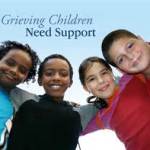Stretching to the new
“Vulnerability is the key to resilience.” – Mitch Carmody
 I hope many of you are finding a way to recharge this season, despite the searing heat wave.
I hope many of you are finding a way to recharge this season, despite the searing heat wave.
My wife and I are both former teachers who used the summer months to stretch—and by that I mean both relaxing, and stretching forward. We read great books and extended our skills. By August I’d begun planning new lessons, trying not to count the days left.
Our work today likewise involves gearing up to take new risks, and try new outreach. She runs our nonprofit bereavement center, which we opened for families like ourselves who struggle in their grief and feel cast off from an unknowing world.
This fall, Hope Floats Healing and Wellness Center, located in Kingston, Ma. south of Boston, will expand supports for grieving children for the first time. In partnership with a local hospice, we’ll host groups of children—little ones, pre-teens, and adolescents—who together do activities that help them process and express what they feel.
Through creative projects like making memory boxes or just playing with others walking a similar road, we anticipate that these children and teens will nurture each other. We’re joining a broader community that offers peer-based supports, led by trained facilitators. People who understand that while kids need boundaries and structures like an opening circle, they also crave making their own choices. People who also know that when kids act out or vent, their behaviors are most often a normal attempt to cope.
As Donna Schuurman, executive director emeritus at The Dougy Center in Portland, Oreg., recently summed up, “Death is a life-altering event, but grief is not a pathological condition.”
For many, doing this work involves an extraordinary vulnerability, which I actually consider a gift.
When my wife Denise set out to start Hope Floats, she took a great risk. She gave up a fulfilling career. She started support groups on the fly, managing every aspect of a fledgling operation.
Mostly, she opened her heart to other families. Having lost our son in a car crash in 2002, she knew too well how a parent’s shock can turn to isolation—and perhaps worse.
Taking in slants of reverent joy.
Pretty soon, she was surrounded by other open-hearted, caring people. Each doing what they could to ease others’ pain.
We are far from alone in doing this. Close to seven hundred child-based centers provide supports for grieving children and teens across the country. Many of these were started from scratch by moms or other relatives, and by supportive providers and social workers.
One key to sustaining this work is having the courage to remain open to face both the darkest stuff, and embrace those occasional uplifting signs of growth.
There’s a similar vein for many adults and children who eventually move forward towards acceptance and even serenity. “They are not running from their grief, they’re running with their grief,” says Mitch Carmody, a grieving dad in Minnesota who is also a speaker and artist.
“The courage to be vulnerable, to take it all in,” Carmody told an audience at The Compassionate Friends national conference earlier this month. “Not half in, but this is my life now, I must take it all in.”
We’ll need more used furniture and art supplies … and we’ll need to take another chance.
Mary Ann Emswiler, a mental health counselor and co-founder of The Cove Center for Grieving Children in Connecticut, expressed this another way recently.
Emswiler, who helped organize early providers of peer-based children’s bereavement, continues to be impressed by the humanity in the field. “The willingness and ability to hold, to cradle really, both crushing grief and abundant joy,” she told the National Alliance for Grieving Children’s annual symposium in June.
“One of the great gifts of doing grief work, I think, is that it grows kindness in us as we recognize our common brokenness.”
Affirming the hundreds of other risk-takers, she urged NAGC attendees to keep stretching, while taking in those slants of what she called “reverent joy.”
“What’s the point saving the world if we can’t, at the same time savor it?” Emswiler asked.
Certainly, there will be much to sort through as we repaint some upstairs rooms at Hope Floats preparing for the kids this fall.
We’ll need more used furniture and art supplies. New creative ideas to help them strengthen bonds with loved ones, and regain some control over events. which may have severed them from friends and community. We’ll learn more about how teens and younger kids deal with separation distress, the circumstances of a loved one’s loss, and their identity angst. The so-called adaptive versus maladaptive responses. We’ll use new assessment tools and metrics.
Mostly, we’ll simply take another chance. Open to the moment when a little girl wants to talk about her dad.
